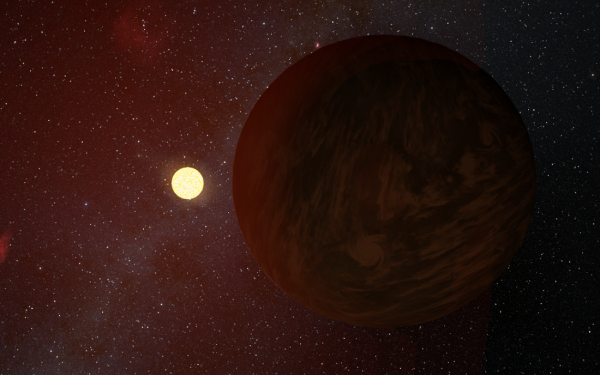BY LETTER
Rajand (Lalande 21185)
Galactography > Regions of Space > Inner Sphere
Galactography > Systems and Worlds > Systems & Worlds Q - R
Galactography > Sephirotic Empires > Zoeific Biopolity
Galactography > Systems and Worlds > Systems & Worlds Q - R
Galactography > Sephirotic Empires > Zoeific Biopolity
 Image from Steve Bowers | |
| Rajand and Dok Saj | |
Rajand System - Data Panel | |
| System | Names: Rajand Location: - Distance from Sol: 8.304 ly (J2000) - Constellation: Ursa Major |
|---|---|
| Star | Names: Rajand, Gliese 411 (Gl 411, GJ 411), HD 95735, HIP 54035, Lalande 21185 Physical characteristics: - Mass: 0.3899 x Sol - Radius: 0.3685 x Sol - Luminosity: 0.02340 x Sol (bolometric) - Temperature: 3,719 Kelvin - Spectral type: M2 V - Rotation period: 56.15 days - Age: 8.047 billion years System: 1) Dok Saj: Videntian SulfoliTerrestrial LapiRhean OxygeoCytherean Semi-major axis = 0.07879 AU, Orbital period = 12.9394 days, Eccentricity = 0.063, Mass = 2.69 x Earth, Radius = 1.354 x Earth 2) Rudodda: AmmoNeptunian CereYdratian AquaCytherean Semi-major axis = 0.5142 AU, Orbital period = 215.7 days, Eccentricity = 0.18, Mass = 3.89 x Earth, Radius = 2.097 x Earth 3) Odhen: CryoazuriNeptunian CereJotunnian AquaMuspellian Semi-major axis = 2.94 AU, Orbital period = 8.066 years, Eccentricity = 0.132, Mass = 13.6 x Earth, Radius = 4.195 x Earth |
 Image from Steve Bowers | |
| A New L4 O'Neill cylinder pair in front of the asteroid New Ajax | |
History
A scientific probe affiliated with the Gengineer Republic was launched towards Lalande 21185 (which the Genetekkers called Rajand) in 405. There, it discovered clement conditions suitable for Terran life within the subsurface ocean of Taamunki, a moon of the ice giant Odhen. This prompted the Genetekkers to assemble a followup crewed mission to the star. The Technocalypse struck before they were able to launch the starship, but fortunately the ship itself survived the disaster unscathed. It was then refitted, loaded with skilled members from the desperate groups of Genetekkers wanting to escape the chaos of Solsys, and launched from its construction site at the Sol-Jupiter L4 trojan asteroid Agamemnon towards Rajand in 568. Without the benefit of boostbeams (as these had been appropriated by GAIA since the onset of the Technocalypse for security reasons), the ship, called the Erwin Chargaff by its passengers, was rather slow. It only arrived at its destination in 721 AT.During the Sundering, the society at Rajand expanded, and another GAIAn ark known as Forever brought additional colonists and skills to the fledgling civilization that its inhabitants proudly referred to as New L4. Contact was established with a small number of colonies around other stars, chief among them being the thriving, sprawling civilization at Ran, and when that star sent an invitation to its interstellar union, known as the Eridanus League, the New L4 civilization agreed to become a part of it.
Some time in the late 840s, things began to fall apart. Within the span of some three years, a combination of internal conflicts between local factions and multiple outbreaks of Technocalypse-derived malware and malevolent replicators swept across the system, killing a large fraction of the inhabitants. Collapse happened within a decade, far too fast for the central League government at Ran to react; when a League system control ship finally arrived in 1013, it discovered only 30,000 sophonts, most of them hardy tweaks, inhabiting the decaying orbital habitats. Ultimately the survivors chose to join the Federation of Sophonts instead, and the system control ship, after assisting with minimum restoration of system infrastructure, amicably departed.
The remnants of the New L4 civilization soon became completely assimilated into the Federation, their surviving cultural elements reduced to little more than a footnote in history. Some of the old, ruined habitats were restored and used as museums. Throughout the Federation era, Rajand became just another undistinguished system acting as a stepping stone for ships traveling to destinations such as Zavijava, Chloris, or Chara. Immigrants were usually aioids looking to seclude themselves from the busy Federation society, as was the case with its neighboring systems Akela and Tiwa. In 1531, the Eridanus League finally returned; a colony ship from Ran arriving and establishing a small League aioid outpost at Rajand-Dok Saj L2.
During the Age of Expansion, the local community was unexpectedly revitalized. Shortly after the fall of the First Federation, a number of Genen groups from the outer Alsafi system began migrating to the star. There, they developed their own civilization in the outer parts of the system known as the Juhon Tan, maintaining respectable distances from the quiet and often reclusive inhabitants of the inner system. Their greatest legacies were a number of clade templates, some of which would later become popular elsewhere in the Terragen Sphere. For a period of some seven centuries, Rajand turned into a local hotspot for clade design. To this day, the system receives a constant stream of pilgrims and is still considered the original home of a number of Genen clades, especially space-adapted bionts of many species.
Related Articles
Appears in Topics
Development Notes
Text by M. Alan Kazlev, updated by Steve Bowers and The Astronomer, April 2022
Initially published on 03 December 2001.
Updated 2024-09-18 by the Astronomer; removed biosphere on Taamunki.
Initially published on 03 December 2001.
Updated 2024-09-18 by the Astronomer; removed biosphere on Taamunki.
Additional Information
All three planets are real planets. Latest information about them as of writing can be found in this paper: https://arxiv.org/abs/2107.09087






